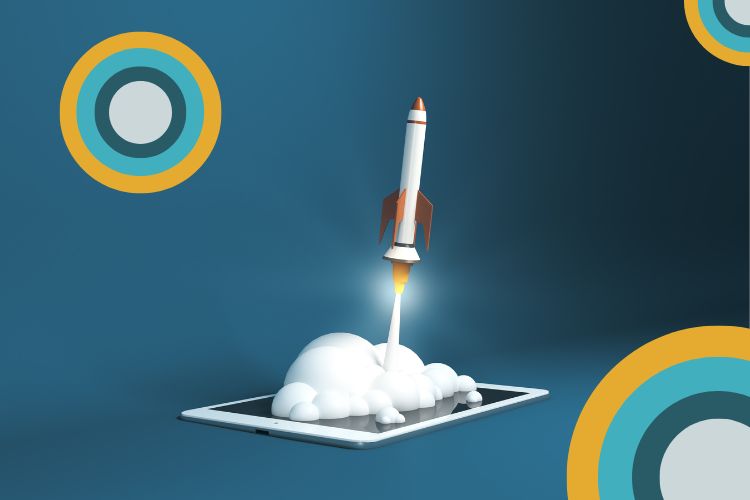What is a technological innovation laboratory?
October 16, 2025

Communication team
Innovation as a driver of competitiveness
In rapidly changing markets, advantage comes not only from launching new products but from learning faster than the competition. To innovate today means questioning how services are created, distributed, and operated, leveraging technologies such as artificial intelligence, automation, cloud computing, and advanced analytics. Companies that turn innovation into a systematic process improve their time-to-market, reduce experimentation costs, and identify opportunities that are not visible from daily operations.
A technological innovation laboratory emerges as the framework that enables doing so methodically: it sets objectives, defines risks, and accelerates the idea–prototype–validation–scaling cycle. It does not replace the business; it complements it by creating a protected space to test hypotheses with real data without disrupting core operations.
Key benefits of this approach:
- Anticipation: identifying trends and business-relevant use cases before they become widespread.
- Validated learning: experimenting with MVPs and pilots while measuring the impact on customers and operations.
- Efficiency: reducing waste of time and resources by prioritizing what demonstrates traction.
- Strategic alignment: connecting technology, product, and finance around common metrics.
What exactly is a technological innovation laboratory?
A technological innovation laboratory is an environment—physical, digital, or hybrid—designed to explore, experiment, and develop technological solutions that deliver real value to an organization or a market.
Its purpose is not just to “research” but to transform ideas into measurable results: more efficient products, processes, or business models.
Unlike a traditional R&D department, an innovation laboratory operates with an agile methodology based on short iterations and continuous validation with users or real data. It does not aim for perfect projects but for prototypes that enable fast learning and improvement based on evidence.
There are different approaches depending on the organization’s structure:
In all cases, the common denominator is the same: creating a space where innovation ceases to be theoretical and becomes practical, measurable, and replicable.

Main functions of a innovation laboratory
A technological innovation laboratory is not an isolated experimentation space but an environment with a concrete mission: to shorten the gap between an idea and its real implementation.
Its success does not depend on how many projects it launches but on how much learning it generates and how many solutions it manages to transfer to the business.
Its main functions include:
1. Technological exploration
The laboratory acts as a trend radar. It analyzes emerging technologies—such as artificial intelligence, predictive analytics, automation, or the Internet of Things—to identify which innovations can create a competitive advantage.
Its goal is not to adopt every new development but to select those that solve real problems and can be integrated into the corporate strategy.
2. Rapid prototyping
Instead of long development processes, laboratories apply agile methodologies (Design Thinking, Lean Startup, Scrum) to turn an idea into a functional prototype within a few weeks.
This phase allows hypotheses to be validated with users or internal teams before investing larger resources, thus reducing the risk of failure.
3. Validation and scaling
Instead of long development processes, laboratories apply agile methodologies (Design Thinking, Lean Startup, Scrum) to turn an idea into a functional prototype within a few weeks.
This phase allows hypotheses to be validated with users or internal teams before investing larger resources, thus reducing the risk of failure.
4. Knowledge transfer and innovative culture
The laboratory also has an educational function: spreading innovative thinking within the organization.
It organizes workshops, training sessions, and cross-departmental projects that break down silos and promote a culture more open to experimentation.
Over time, it ceases to be just a “department” and becomes a cultural engine, capable of fostering a mindset of trial, error, and continuous improvement.
5. Connection with external ecosystems
The most powerful innovation arises when connected to the environment.
Laboratories establish partnerships with universities, startups, technology centers, or investment funds to create a constant flow of new ideas and talent.
This openness allows access to complementary solutions, knowledge sharing, and the identification of strategic collaboration opportunities.
In summary, a technological innovation laboratory is the meeting point between curiosity, experimentation, and business strategy.
It does not aim to invent for the sake of inventing but to transform innovation into real and sustained growth.
Benefits of implementing a technological innovation laboratory
Adopting a technological innovation laboratory is not just a matter of image or modernity: it is a strategic decision that transforms the way an organization learns, adapts, and competes.
The benefits manifest both at the operational and cultural levels and are amplified over time as innovation becomes integrated into the business structure.
1. Acceleration of digital transformation
A laboratory allows technologies to be tested before mass adoption, minimizing risks.
Instead of waiting for a trend to consolidate, the company experiments on a small scale, measures results, and scales what works.
In this way, digitalization ceases to be an abstract project and becomes a continuous improvement process.
2. Innovation without disrupting daily operations
One of the biggest obstacles to innovation is the lack of time and focus within daily operations.
The laboratory acts as a parallel and safe space where teams can explore solutions without affecting the productivity of the core business.
In this way, the organization maintains its operational pace while advancing in its technological evolution.
3. Attraction and retention of talent
The most in-demand technology profiles seek environments that allow them to create, learn, and experiment.
A well-structured laboratory becomes a talent magnet because it offers autonomy, purpose, and exposure to high-impact projects.
Additionally, it helps retain professionals by promoting continuous learning and the development of emerging skills.
4. Reduction of innovation risks and costs
Innovation is not cheap, but failing without a method is much more expensive.
By working with prototypes and early validations, the laboratory drastically reduces spending on failed projects and improves resource allocation.
Each lesson learned during an experimental phase increases efficiency in future technological investment decisions.
5. Generation of measurable value
The results of a laboratory can materialize in various formats:
- -New products or services.
- -Internal tools that optimize processes.
- -More scalable or sustainable business models.
- -New partnerships with startups or technology partners.
In all cases, the value lies not only in what is created but also in the acquired ability to innovate in a structured and replicable way.
6. Connection with the innovation ecosystem
Participating in a laboratory opens the door to strategic collaborations with universities, institutions, research centers, and other companies.
This network allows for sharing risks, resources, and knowledge, promoting co-creation as a way to solve complex challenges.
Ultimately, a technological innovation laboratory is not an expense but an investment in organizational learning.
Its impact is measured in speed of adaptation, efficiency, and resilience—three attributes that define the leading companies of the new digital economy.

Technological Innovation Trends 2025
The concept of a technological innovation laboratory is evolving alongside the technologies that support it. In 2025, the most relevant trends are not only about new tools but also about
Artificial intelligence as the foundation of innovation
AI ceases to be an experimental tool and becomes the structural layer of innovation processes.
Technological laboratories use artificial intelligence to:
- Detect market patterns and anticipate opportunities.
- Generate faster prototypes or simulations using generative AI.
- Automate research and development tasks.
- Assess the feasibility of ideas using predictive analytics.
The trend indicates that, in the coming years, every innovation laboratory will also be an AI Lab, capable of combining human creativity with automated reasoning.
From the physical laboratory to the hybrid ecosystem
The traditional model—a physical space with teams working on-site—is giving way to distributed and digital structures.
Remote work, collaborative tools, and cloud-based innovation platforms enable the creation of global laboratories, where experts, startups, and partners from different countries participate.
This approach increases agility and democratizes access to innovation, reducing dependence on a single location.
Sustainable innovation and green technology
Sustainability is no longer a value-added feature; it is a strategic priority.
Technological laboratories incorporate energy efficiency, digital footprint reduction, and circular economy criteria into their projects.
This gives rise to so-called Green Labs, focused on developing solutions that balance profitability and environmental impact, from optimizing data centers to intelligent resource management.
The rise of the “Innovation-as-a-Service” model
Many medium-sized companies cannot maintain their own laboratory, so they turn to outsourced innovation models, known as Innovation-as-a-Service.
These services provide access to experts, methodologies, and technological resources on demand.
It is a more flexible and accessible model that allows innovation without the need for large infrastructures, particularly attractive for SMEs and corporations undergoing transformation.
Convergence between venture building and corporate laboratories
Increasingly, organizations are combining the laboratory function with the ability to create internal startups or spin-offs, adopting a venture builder approach.
The laboratory thus becomes a factory for new digital businesses, capable of validating ideas, forming teams, and attracting investment.
This hybrid model accelerates applied innovation and opens a new frontier between research and business creation.
Culture of continuous experimentation
Beyond technologies or business models, the overarching trend is cultural:
the companies that thrive in 2025 are those that experiment constantly, measure results, and learn from every failure.
Innovation ceases to be a one-off project and becomes an organizational routine, supported by leadership, data, and purpose.
Beyond technologies or business models, the overarching trend is cultural:
the companies that thrive in 2025 are those that experiment constantly, measure results, and learn from every failure.
Innovation ceases to be a one-off project and becomes an organizational routine, supported by leadership, data, and purpose.
How we drive innovation at Manix Capital
At Manix Capital, innovation is not seen as a department or an external service; it is a structural part of our growth model.
Our purpose is not only to invest in technological projects but to create, support, and scale solutions that transform entire sectors.
At the heart of this philosophy is our Studio Lab, an environment where ideas become tangible products.
The Studio Lab: our creation ecosystem
Manix Capital’s Studio Lab functions simultaneously as a technological innovation laboratory and a venture studio.
Here, ideas are developed and validated by combining three fundamental pillars:
- 1. Applied technology, focusing on artificial intelligence, automation, and advanced software.
- 2. Digital strategy, focused on solving real business problems and generating measurable impact.
- 3. Entrepreneurial mindset, driving the creation of projects from scratch with agility and market vision.
In this space, technical, creative, and business teams converge to prototype, test, and launch new digital models.
Every initiative born in the Studio Lab follows a clear roadmap: ideation, validation, development, and scaling.
Innovate with purpose
At Manix Capital, we understand innovation as a tool for sustainable progress.
Our projects integrate principles of energy efficiency, digital inclusion, and technological responsibility, aiming to balance profitability and social impact.
Each initiative begins with a guiding question:
“How can technology improve people’s lives and enhance business competitiveness?”
A replicable creation model
The Studio Lab not only drives its own projects but also collaborates with startups and companies seeking to innovate methodically.
Through strategic partnerships, mentoring, and shared development, we help transform ideas into market-ready solutions.
Our goal is not to accumulate projects but to build an ecosystem that generates constant and self-sustaining innovation.
The future belongs to those who experiment
The speed of technological change leaves no room for stagnation. The companies that will thrive in the coming years will not necessarily be the largest, but those that learn fastest, collaborate best, and experiment with purpose.
A technological innovation laboratory is not a luxury reserved for large corporations; it is a strategic tool that any organization can adopt to anticipate the future, diversify its knowledge, and strengthen its adaptability.
Manix Capital was born precisely from this vision: the conviction that innovation should not remain theoretical but be translated into real, sustainable, and scalable solutions.
Our Studio Lab embodies this commitment: a space where curiosity becomes strategy and technology becomes tangible growth.
In an environment where the rules change daily, the only constant is experimentation.
That is why, at Manix Capital, we continue exploring, connecting, and building the future from today.
Discover how we turn technological ideas into real projects from our Studio Lab.
FAQs
What is a technological innovation laboratory?
A technological innovation laboratory is a space—physical, virtual, or hybrid—where companies explore, test, and develop new technology-based solutions. Its goal is not only to create products but to transform ideas into measurable results, such as process improvements, new business models, or digital tools.
Unlike a traditional R&D department, an innovation laboratory operates with agile methodologies that allow concepts to be prototyped and validated quickly, reducing risks and accelerating the adoption of emerging technologies such as artificial intelligence, cloud computing, or automation.
In essence, it is the meeting point of creativity, technology, and business strategy: an environment designed to learn quickly, fail with purpose, and turn innovation into real growth.
What is the purpose of a technological innovation laboratory?
Its main function is to accelerate innovation within an organization. A technology laboratory allows experimentation with new ideas without disrupting daily operations, identifies opportunities before the competition, and applies solutions that improve efficiency, customer experience, or sustainability.
Additionally, it acts as a cultural catalyst, promoting an open mindset toward change and continuous learning. In many cases, it also serves as a bridge between the company and its ecosystem—universities, startups, or research centers—facilitating collaboration and knowledge transfer.
Therefore, more than just a testing space, an innovation laboratory becomes a strategic tool for reinventing the way a company evolves.
What activities are carried out in a technological innovation laboratory?
In an innovation laboratory, multiple activities are carried out aimed at experimenting, validating, and scaling new solutions.
Some of the most common include:
- Technological exploration: analysis of emerging trends and assessment of their applicability to the business.
- Rapid prototyping: creation of initial versions of products or services to test their feasibility.
- Hypothesis validation: testing with users, customers, or real data.
- Internal training: workshops and activities to foster an innovative culture throughout the organization.
- External co-creation: collaboration with startups or technology partners. Each activity aims to generate learning and turn innovation into tangible value, not just ideas.
Why do companies need a technological innovation laboratory?
Because technology changes faster than traditional models can adapt, a technological innovation laboratory provides companies with the agility and the right environment to experiment without putting operations at risk.
It helps reduce uncertainty, optimize resources, and identify new market opportunities before the competition.
Additionally, it fosters a more open, collaborative organizational culture focused on continuous learning. In an environment where disruption is constant, not innovating is the greatest risk; having a specialized laboratory is the best way to maintain long-term relevance and competitiveness.
What is the difference between an innovation laboratory and an R&D department?
Although both aim to create value through technology, their focus is different.
The R&D (research and development) department usually concentrates on technical or scientific advances in the medium to long term, with more structured processes and formal outcomes.
In contrast, a technological innovation laboratory has a more agile, experimental, and business-oriented approach. Its goal is to quickly validate ideas, measure impact, and turn what works into real solutions.
It could be said that the laboratory is the bridge between creativity and practical application, while R&D represents the scientific foundation that supports innovation.
What type of professionals work in a technological innovation laboratory?
The success of a laboratory depends on the diversity of its team. It is usually composed of technologists, designers, analysts, business strategists, and data experts, among other profiles.
The key is interdisciplinary collaboration: bringing together those who understand technology with those who know the market’s needs.
Additionally, the best laboratories foster an environment where all members can propose, test, and fail quickly, prioritizing creativity, curiosity, and practical problem-solving over hierarchy.

